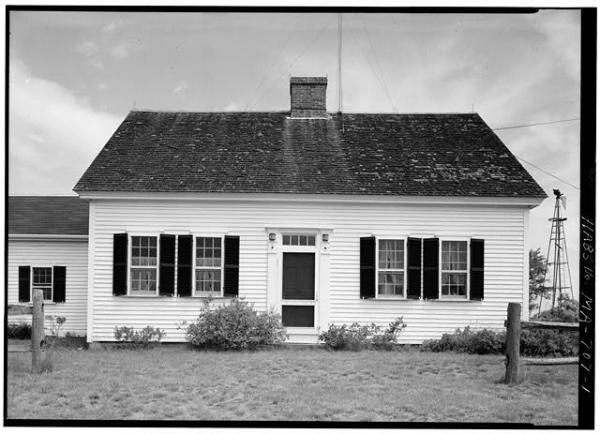
I have been perusing this out of print book: Truro - Cape Cod, Landmarks and Seamarks by Shebnah Rich (1888). I have a copy of the book, and wonder how in the world it got online.
Cape Cod began growing in European (English) population around 1630.
Farming and fishing were the main occupations. The soil was rich then due to the old forests. Today, there is no topsoil left. By 1750 there were few trees left on the Cape due to lumbering, land clearing for farming, and for fuel. The scrub oak and pine that predominate today is not the tall virgin hardwood forest that the colonists encountered.
Everybody grew things and raised animals. There was not much cash except from fishing and boat-building, and there were no shops. Main subsistence crops: orchards, maize, pumpkin and squash, root vegetables, beans, rye. No wheat, no flour, no sugar unless very wealthy - but there was molasses from the West Indies. Also, pigs, steer, milk cows, chickens, and horses for transportation. Cranberries, raspberries, blackberries, and blueberries grew wild. There were plenty of deer and rabbits too, and of course abundant shellfish. Beans with a little pork was a standard meal. People baked their bread once a week, made of mixes of corn (maize) and rye flour. Food: Early American food and drink
When you slaughtered a hog or steer, you shared the meat with neighbors. They did the same.
You were allowed to shoot a wolf or a "problem Indian" but the Indians were not much of a problem and soon settled into Indiantowns and learned English. King Philip's War was not a big deal on Cape Cod.
A village Meeting House served many purposes including local government meetings and church. Most of the early congregations were "united," ie Methodist and Congregational worshipping together. In the early days there was a hot market for pastors and Harvard began grinding them out in 1636 to meet the demand. Like the Boston colonists, the Cape Codders were not Puritans like the Plymouth group.
Other than local rules made in town meetings, there was no "government" in evidence at all. Town officials were by vote, and volunteers. There were no police but there were informal militias. Every adult male citizen was required to own a firearm (mostly matchlocks). Later on, recruiters would pass through towns demanding recruits for the French and Indian War. The structure of grammar schooling varied widely from village to village.
Truancy from church was a crime. So was swearing. Sunday church services generally had two one-hour sermons and around an hour of prayer. The service was around four hours in all. No music, of course, and no communion. Those were Papist things. Each church had a guy assigned to wake up drowsers with a long stick with a feather on one end (for the ladies) and a knob on the other end (to conk the drowsy men on the head). A fun task, no doubt.
Thanksgiving: There were fall harvest Thanksgiving feasts all over the Cape. Nothing to do with the original Pilgrims, just a traditional harvest time thanks to God. The Pilgrim Thanksgiving? They had very little to be thankful for with half their group dead in that first winter, but they were anyway. Remember, they were headed for the already established town of New Amsterdam (New York), not Massachusetts. Got blown off course.
There were windmills all over the Cape, very early. Their main purposes were making corn or rye meal, or for filling up salt flats for salt production (to make salt cod).
Fishing meant mostly Cod on George's Bank, but later Mackeral too. Some guys were fishing schooner skippers by 25. Some of them went on to be transoceanic ship captains. There was some near-shore whaling, and the occasional stranding of a pod of Blackfish (aka Pilot Whales) was hitting the jackpot.
Alcohol: Cider.
Death: Mainly infectious diseases of early childhood. Some TB in young adulthood. Also, puerperal fever killed a lot of wives so men often went through a series of them. After that, fishermen drowning was the main cause - which provided widows for the widowers. If you escaped those things, most people lived into their 80s. (Those childhood death rates and accident death rates are what skews old-time life expectancy data and thus the averages are meaningless.)
Illumination and heat: Fireplaces for heat, and one in the kitchen for cooking. Wood stoves came much later. Bayberry candles, whale oil lamps.
Transportation, etc: Roads were terrible. Transportation was mainly by water and to be a town you needed a harbor. With its fine harbor, Provincetown was the largest on the Lower Cape. Early on, there was regular travel and mail, via Boston packets.
We might consider these settlers poor and deprived, but all they saw was abundance, faith, and hope. Life was hard and highly uncomfortable (by our standards), and was expected to be. You fended for yourself. If judged utterly helpless, the church came to your aid.
Housing: The history of colonial housing is an interesting one, mostly borrowed from England and from Holland in areas around New York. However, the rural Cape Cod cottage was an American invention and typical on colonial Cape Cod. No plumbing. Every village had an amateur post and beam carpenter in an era where most trades were amateur and everybody was a farmer, including schooner skippers, pastors, and doctors.
Photo on top is the Jonah Atkins house, Truro, Mass.


